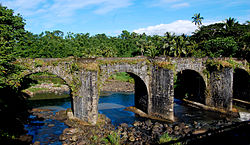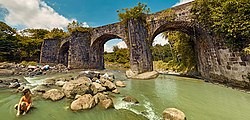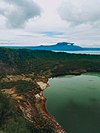| Malagonlong Bridge Tulay ng Malagonlong (Filipino) | |
|---|---|
 The bridge in 2011 The bridge in 2011 | |
| Coordinates | 14°00′47″N 121°37′01″E / 14.012940°N 121.616844°E / 14.012940; 121.616844 |
| Crosses | Dumaca River |
| Locale | Tayabas, Quezon |
| Other name(s) | Puente de Malagonlong (Spanish) |
| Heritage status | National Cultural Treasure under the Historic Bridges of Tayabas |
| Characteristics | |
| Design | Arch bridge |
| Material | Adobe stone, Limestone and Molasses |
| Total length | 445 ft (136 m) |
| No. of spans | Five |
| History | |
| Architect | Fray Antonio Mateos |
| Constructed by | People of Tayabas |
| Construction start | 1841 |
| Opened | 1850 |
| Location | |
The Malagonlong Bridge (Spanish: Puente de Malagonlong) and (Filipino: Tulay ng Malagonlong) is a five-span 445 ft (136 m) long stone arch bridge built during the Spanish colonial period in Tayabas, Quezon, Philippines. The bridge is known as one of the oldest bridges as well as the longest bridge made during the Spanish era. It was declared a National Cultural Treasure under the Historic Bridges of Tayabas on August 12, 2011.
Location

The Malagonlong Bridge crosses the Dumacaa River and connects Barangay Mateuna and Lakawan to the eastern side of Tayabas as well as the municipalities of Mauban and Pagbilao.
Description
The stone arch bridge has a total length of 445 ft (136 m). The first arch has both height and width of 36 ft (11 m); the second arch also has a height and width of 33 ft (10 m); the fourth arch has a width of 30 ft (9.1 m) and the fifth arch has a width of 18 ft (5.5 m). The bridge has a carriageway of about 6 m (20 ft) and six small balconies where pedestrians can stop by.
It became a bridge for tourists rather than for vehicular traffic after a new bridge was built parallel to it. It is currently owned and managed by the local government unit of the municipality of Tayabas.
History

The bridge was built between the years 1840 and 1850 under the direction of the Fray Antonio Mateos, a Franciscan priest who served as the Ministro del Pueblo of Tayabas. In an account of a Spanish traveler Juan Alvarez Guerra, the bridge was built in 1841 under Gobernadorcillo Don Joaquin Ortega's term. The bridge was made by the people of Tayabas through forced labor. It is estimated that 100, 000 adobe blocks was used to build the bridge. An inscription on the bridge indicates that it was inaugurated in 1850 under the term of Gobernadorcillo Don Julian S. Francisco.
The bridge was declared by the National Historical Institute (now National Historical Commission of the Philippines) as a marked historical structure by placing a historical marker. In 2010, the local government of the municipality of Tayabas declared the eleven historical bridges of Tayabas, including Malagonlong Bridge, a historical bridge for protection purposes. The eleven bridges of Tayabas are:
| Bridge | Location | Year Finished |
|---|---|---|
| Puente de Alitao | Alitao River, Poblacion | 1793 |
| Puente de Isabel II | Iyam River, Brgy. Baguio | 1853 |
| Puente de Urbiztondo | Malao-a River, Barangay Malao-a | 1854 |
| Puente de Don Francisco de Asis | Domoit River, Brgy. Domoit | 1854 |
| Puente de Bai | Bai Creek, Brgy. Dapdap | n.d |
| Puente de las Despedidas | Malaking Ibiya, Brgy. Lalo | n.d |
| Puente de la Ese | Ibiyang Munti, Brgy. Camaysao | n.d |
| Puente de la Princesa | Ilayang Dumacaa (Upper Dumacaa), Brgy. Matuena | n.d |
| Puente del Malogonlong | Dumacaa River, Brgy Matuena | 1850 |
| Puente del Lakawan | Lakawan River, Brgy. Lakawan | n.d |
| Puente del Mate | Mate River, Brgy. Mate | n.d |
| Legend: n.d means No date | ||
See also
References
- ^ Guerra, Juan Alvarez. (1878). De Manila a Tayabas (Viajes por Oriente). Translated by Misael Mayol Pedrano, May 1985.
- ^ Gonzales, Ana Maria. (2006). Bridging the Past, Present and Future: A Conservation Management Action Plan for Malogonlong Bridge Tayabas, Quezon Province.
- National Museum of the Philippines. (2011). Annual Report 2011.
- ^ Redor, Jun V. (July 15, 1997) "11 Tulay na Bato sa Tayabas” (Eleven Stone Bridges in Tayabas). A listing and description of 11 stone bridges in Tayabas.
External links
 Media related to Malagonlong Bridge at Wikimedia Commons
Media related to Malagonlong Bridge at Wikimedia Commons
